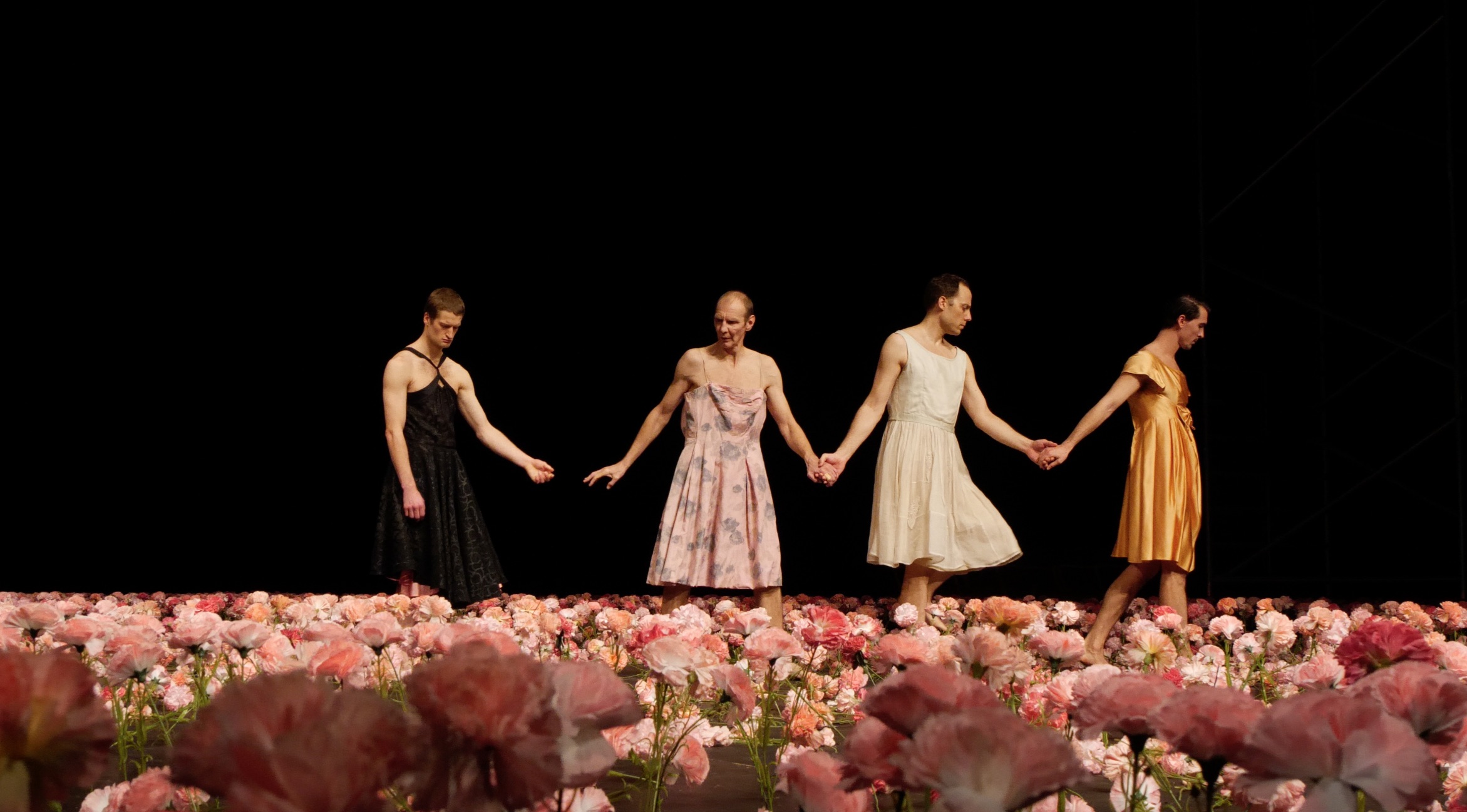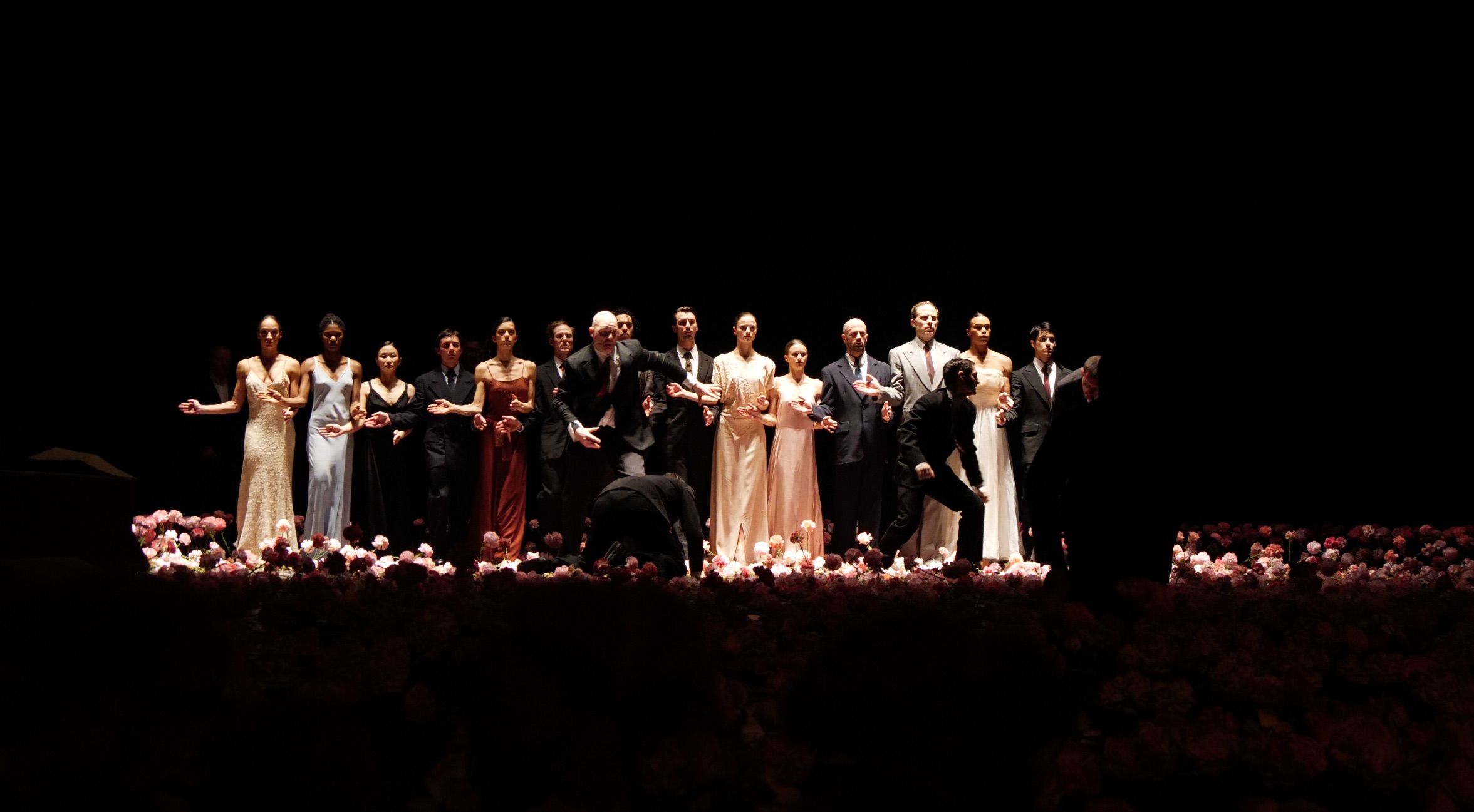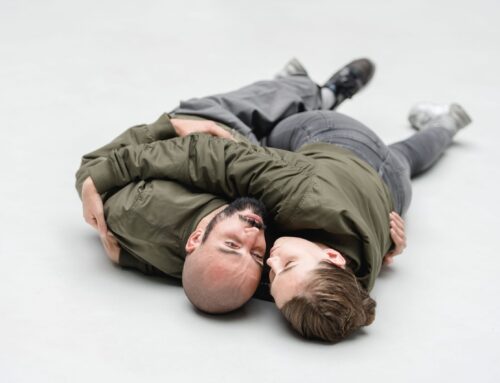Reenactment of Pina Bausch’s NELKEN
The live of the others…
Night review by Klaus Dilger
HERE you can find our video impressions
A sparsely lit field of thousands of carnations, as an entrance atmosphere on the open stage of the Wuppertal Opera House. The ideal backdrop, it seems, for many a „selfie“ of the première visitors to the revival of the legendary Pina Bausch piece from 1982.
The announcement on the loudspeaker to please switch off your mobile phones now announces the start of the performance. Then, one by one, women in elegant silk dresses on high heels stalk onto the stage and carefully through the sea of flowers. Some carry padded chairs with armrests, as do the men in their old-fashioned suits. The hall lights have not yet gone out. They place their chairs amongst the flowers, but in such a way that they do not cover the open space. The light becomes warmer, brighter, more theatrical, bathing the summer-fresh gathering in a pleasant evening light that nevertheless cannot mask the palpable tension of the people there.
„…the world is beautiful when you tell it like a fairy tale…“, an operetta singer belts out Franz Léhar’s melody over the huge field of carnations.
Then silence. The man in the elegant black suit and black bow tie (Andrey Berezin) rises. His every step is clearly audible as he strides to the stage ramp without touching a flower and looks at the audience from there. He then moves from the stage into the auditorium, discreetly but firmly addresses an elderly gentleman in the ninth row and asks him to accompany him outside. Other dancers follow his example at short intervals. A good twenty people are gradually removed from the audience before the performers return to the stage and disappear with their seats. A single dancer remains behind, steps into the centre of the stage and begins to translate his words into sign language in synchrony: „I’m waiting for the man I love…“
This is how Pina Bausch begins her piece in Peter Pabst’s ingenious stage design.
Its symbolic language of the eponymous carnations may seem dreamy to some, like paradise filled with pure love, as the evening’s programme booklet suggests. Others see it as a symbol of the bourgeois establishment and a Mother’s Day gift. It is far more complex than that.
There is much to suggest, at least according to the reviewer’s interpretation, that they could refer on a further level to the „socialist peasant and workers‘ state“, which had chosen the carnations as its state symbol, or in a broader sense to societies in which the freedom of the individual is suppressed. Would the popular cemetery flowers (the carnations), the „free field“, thus expose the death zones with which the former GDR wanted to deter its citizens from fleeing? Won’t metre-high scaffolding be added later, towering over the field like watchtowers? The stage action also points the way to this possible decoding: uniformed men with sheepdogs, thugs in dark suits, passport controls, surveillance, inhumane treatment and humiliation, Stasi surveillance methods and purges…., as in the opening scene described above.
And last but not least, the world-famous image of the skinny, half-naked accordion player striding through the field of carnations, silently looking at us onlookers and disappearing again in the same way she came. Then we realise: this seemingly romantic ground is also an abyss.
Images of people who were so emaciated that we no longer know whether they were men or women and who only survived the Nazi concentration camps in which Jews, Roma, dissidents, gay men and women were exterminated because they were artists and were able to play in the concentration camp orchestra as musicians to entertain the exterminators.
What a powerful and deeply shattering choice by the choreographer to have the accordion player perform twice in conjunction with the man who is waiting for the man he loves.
The men in Pina Bausch’s NELKEN don’t even have any tears left to cry. She has Andrey Berezin chop mountains of fresh onions for them to bury their heads in at a „fairground stall of tears“.
This is the view into the abyss that is omnipresent beneath the field, especially at the time the play was written, in the early 1980s, when so many had lost their loved ones at a young age.
„Waiting for the man I love…“
and again the accordion player steps onto the carnation field. Listens. And then she translates the words into sign language: „Spring, summer, autumn and winter…“
With Margot Friedländer still in the critics thoughts, the ensemble returns to the stage with the now famous „Carnation Line“.
Pina Bausch’s message is deeply human
A piece about love
„NELKEN“ is a play about love, for people, for whatever gender and in whatever form. And an ode to „being different“, „being yourself“ and being allowed to do so, a loving hymn to truthfulness, to breaking out and gentle revolution, wherever this seems to be in danger, and to the power of the individual and of art anyway. – Each of the thousands of carnations covering the stage appears to be unique, just as every memory seems to be unique and yet divisible.
Pina Bausch succeeds in creating magnificent images, often humorous, even exuberant, which the well-organised ensemble celebrates and shares with joy. In children’s games – „Un, deux, trois, soleil“ – in which subversion and rebellion against rules and authorities subtly creep in – outstanding in the literal sense of the word Taylor Drury on the shoulders of Alexander Lopez, who act like a joint body and find answers to take the norms ad absurdum. It’s great fun to watch them all take such delight in shaking up the rigid structure. The same goes for the colourful scenes in which the dancers, all in colourful women’s dresses like rabbits, hop away from their henchmen in uniform, their sheepdogs and Andrey Berezin or dance exuberantly on and under tables.
This is skilfully and lightly done by all those involved, who have created, recreated and filled this work with life and yet they all remain highly concentrated, because power and powerlessness, oppression, violence and even torture are omnipresent or lurking around the corner and death is a constant companion (also musically with Schubert’s „Death and the Maiden“.
– Just life – just love –
In each of these rapidly shifting moods and sequences of scenes, during the 110 minutes without intermission, the young ensemble performs with a credibility and authenticity that one could hardly have expected beforehand.
The genius, complexity and depth of Pina Bausch’s art becomes tangible and visible.
Images from films that have burned themselves into the memory: the excellent scene at the very end of the stage, for example, when the dancers, lined up in a revue-like line in the spotlight, throw away their left arm in synchronisation with their right hand, creating a clapping sound as if they were applauding mechanically, while dark, muscular figures in the shadows beat up other people. Bob Fosse’s „Cabaret“ with Liza Minelli and Joel Grey immediately comes to life…
masters and their works among themselves.
The number of great moments in NELKEN is so numerous that a review can only invite you to experience them for yourself. And here, too, every experience will probably be unique, because art also makes your own life resonate and is thus able to expand it. Pina Bausch’s work is characterised by the fact that the source from which it draws always points beyond the moment and the time of its creation. NELKEN is one of the choreographer’s most touching, perhaps most personal works, close to TEN CHI.
Towards the end, Bausch invites the audience to rise from their seats and shows how easy it is to exude love and humanity with four gestures if they are not centred solely on themselves or remain in empty space, but can become an embrace when turned towards the respective seated partners. It’s amazing how easy it can be to share everything you’ve seen over the last hour and a half in the most heartfelt way between two bodies and people who may have been strangers to each other until then.
The dancers will also return to the stage one after the other, always with their arms above their heads in the fifth position, to share with the audience why they have become dancers and then gather for the final group photo.
Smiles, relief, black-outs, thunderous final applause.
„Dance is an ensemble performance“
Bringing a work like NELKEN to life in performances and sharing it with an audience is the goal to which all the protagonists must be committed, and they can only realise it together, provided they are deployed in the right place with their abilities.
Not everything is perfect yet
There are occasional weaknesses in the evening, such as the artists‘ speech intelligibility. These will presumably disappear with increasing confidence and extra work.
The only thing that the two rehearsal directors Silvia Farias Heredia and Eddie Martinez should reconsider is the role of the accordion player and her casting, who have otherwise produced a brilliant new production.
It fills us with hope to see that the ensemble seems to have the joy and fun of bringing this Pina Bausch piece to the stage in a credible and convincing way and together. Appropriating Pina Bausch’s work without fear will prove to be the right approach.
Reginald Levebvre is not Lutz Förster, but he’s not supposed to be. Simon Le Borgne is not Dominique Mercy, nor should he be. But both did an excellent job and so did everyone else!
Perhaps the dancers who had the privilege of opening the door to a new understanding of dance together with Pina Bausch and all her congenial artistic partners, such as Rolf Borzik, Marion Cito, Peter Pabst and Matthias Burkert, were all and every one of them „apparitions“ who could make the air shimmer with every appearance on stage. These artists of the new generation do not have this privilege in their luggage.
But on the opening night, together as an ensemble, they made the air shimmer with Pina Bausch’s work!
Andrey Berezin, Dean Biosca, Naomi Brito, Emily Castelli, Maria Giovanna Delle Donne, Taylor Drury, Letizia Galloni, Luciény Kaabral, Simon Le Borgne, Reginald Lefebvre, Nicholas Losada, Alexander López Guerra, Julian Stierle, Christopher Tandy, Tsai-Wei Tien, Aida Vainieri, Frank Willens

















